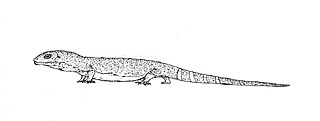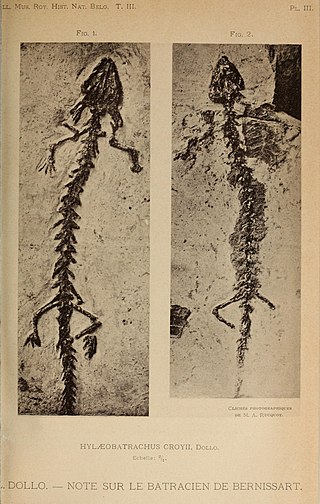| Comonecturoides Temporal range: Late Jurassic, | |
|---|---|
| Scientific classification | |
| Kingdom: | |
| Phylum: | |
| Class: | |
| Order: | |
| Genus: | †Comonecturoides Hecht & Estes, 1960 |
| Type species | |
| †Comonecturoides marshi Hecht & Estes, 1960 | |
Comonecturoides is an extinct genus of prehistoric caudate amphibians, possibly a salamander, from Reed's Quarry 9 of the Morrison Formation, near Como Bluff, Wyoming; the type species is C. marshi. [1] [2] [3] It is considered a nomen dubium because the name is based on non-distinctive remains which cannot be classified in detail. [3]

Albanerpeton is an extinct genus of salamander-like albanerpetontid amphibian found in North America, Europe and Asia first appearing in Cretaceous-aged strata. There are eight described members of the genus, and one undiagnosed species from the Paskapoo Formation, making it by far the most speciose genus in the family. Members of the genus had a robust head and neck which likely allowed them to actively burrow, characteristic of fossorial species, and they lived in a wide range of environments. This genus of amphibian was the last of its order, surviving until into the Early Pleistocene (Gelasian) of northern Italy, and possibly northern Spain, until around 2 million years ago. It likely became extinct when the region developed its present Mediterranean-type climate, having preferred one that was cold and humid. The monophyly of Albanerpeton has recently been questioned, with some authors regarding the genus as paraphyletic.

The Albanerpetontidae are an extinct family of small amphibians, native to the Northern Hemisphere during the Mesozoic and Cenozoic. The only members of the order Allocaudata, they are thought to be allied with living amphibians belonging to Lissamphibia. Despite a superficially salamander-like bodyform, their anatomy is strongly divergent from modern amphibians in numerous aspects. The fossil record of albanerpetontids spans over 160 million years from the Middle Jurassic to the beginning of the Pleistocene, about 2.13–2 million years ago.
Apricosiren is an extinct genus of prehistoric salamander. Known from the Berriasian aged Lulworth Formation in southern England.
Batrachosauroides is an extinct genus of prehistoric salamander known from several sites across the United States. The two identified species are Batrachosauroides dissimulans and Batrachosauroides gotoi. A proposed, unidentified third species has been proposed by paleontologist James Gardner based on the discovery of a dental fossil in the Bushy Tailed Blowout area of the Lance Formation fossil grounds, but has not been definitively identified as a new species or as part of either of the two identified species.
Galverpeton is an extinct genus of prehistoric salamander. It lived during the Barremian-Aptian stages in the Early Cretaceous, in what is now Western Europe. The type species, Galverpeton ibericum, was described by Estes and Sanchíz in 1982. It was found in the Castellar Formation, part of the Galve fossil assemblage. The fossil is in the Institut Paleontologic Miquel Crusafont, Sabadell.
Iridotriton is an extinct genus of prehistoric salamander known from a fossil found in stratigraphic zone 6 of the late Jurassic Morrison Formation in the Dinosaur National Monument. One species has been described, Iridotriton hechti. It is likely a member of Cryptobranchoidea.

Hylaeobatrachus is an extinct genus of prehistoric salamander, known from the Early Cretaceous of Europe. The type species H. croyii is known from the Sainte-Barbe Clays Formation at the Iguanodon locality of Belgium, and was described by Louis Dollo. An unnamed Hylaeobatrachus-like taxon has also been reported from Las Hoyas, Spain. Both localities are of Barremian age. Hylaeobatrachus belongs to the crown group of modern salamanders, though its exact relationship with modern salamander groups is uncertain. It was neotenic, llike some modern salamanders.
Lisserpeton is an extinct genus of prehistoric salamander of the Hell Creek Formation. Its closest living relatives are the mole salamanders.
Kokartus is an extinct genus of prehistoric stem-group salamander (Caudata) from the Middle Jurassic Balabansai Formation of Kyrgyzstan.
Monsechobatrachus is an extinct genus of prehistoric frogs. It is known from a complete but very poorly preserved skeleton from Monsech in Spain.
Prodesmodon is an extinct genus of prehistoric salamander, first described from the Lance Formation.
Proamphiuma is an extinct genus of prehistoric amphibian found in the Bug Creek Anthills in the Hell Creek Formation.

Scapherpeton is an extinct genus of prehistoric amphibian. Fossils of it have been found in the Hell Creek Formation.

The Morrison Formation is a distinctive sequence of Late Jurassic sedimentary rock that is found in the western United States, which has a wide assortment of taxa represented in its fossil record, including dinosaur fossils in North America. It is composed of mudstone, sandstone, siltstone and limestone and is light grey, greenish gray, or red. Most of the fossils occur in the green siltstone beds and lower sandstones, relics of the rivers and floodplains of the Jurassic period.
Enneabatrachus is an extinct genus of prehistoric frogs known from the late Jurassic Morrison Formation of the United States and also the Late Jurassic-Early Cretaceous Ksar Metlili Formation of Morocco. The type species is E. hechti, whose remains have been recovered from stratigraphic zone 5.
Theretairus is a Late Jurassic genus of sphenodont reptile from the Morrison Formation of western North America, present in stratigraphic zones 5 and 6.
Comobatrachus is a dubious genus of extinct frog known only from the holotype, YPM 1863, part of the right humerus, found in Reed's Quarry 9 near Como Bluff, Wyoming in the Late Jurassic-aged Morrison Formation. The holotype was commented on but not described by Moodie in 1912, although it was probably discovered alongside the holotype of Eobatrachus, but was not described by Othniel Charles Marsh when he named Eobatrachus in 1887. The type, and only species, C. aenigmatis, was named and described in 1960. It was probably related to the contemporaneous Eobatrachus.
Eobatrachus is a dubious genus of extinct frog known only from the holotype, YPM 1862, part of the right humerus, found in Reed's Quarry 9 near Como Bluff, Wyoming in the Late Jurassic-aged Morrison Formation. The type, and only species, E. agilis, was named by Othniel Charles Marsh in 1887 and he initially interpreted it as a mammal, although it was later re-classified as a genus of frog related to Comobatrachus and Eobatrachus is now seen as a dubious amphibian genus, possibly belonging to Anura (frogs) according to Foster (2007).

Uteodon is a genus of herbivorous iguanodontian dinosaur. It is a basal iguanodontian which lived during the late Jurassic period in what is now Uintah County, Utah. It is known from the middle of the Brushy Basin Member, Morrison Formation. The genus was named by Andrew T. McDonald in 2011 and the type species is U. aphanoecetes.
Batrachosauroididae is an extinct family of prehistoric salamanders with holarctic distribution. They were paedomorphic and presumably aquatic. They are possibly the sister taxon of Proteidae, an extant family of aquatic salamanders. They are definitively known from the Late Cretaceous to Miocene of North America and Europe. Remains from the earliest Cretaceous (Berriasian) Lulworth Formation of England have tenatively been attributed to this family.